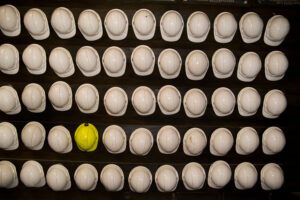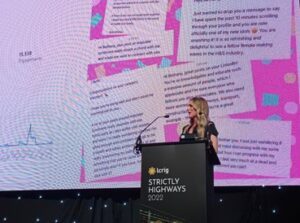construction
“It’s not about setting KPIs for the number of women within an organisation, it must go beyond than that” – Beth Holroyd on the importance of female representation
Women may only make up 14% of the construction industry and only 21% of the IOSH membership. Beth Holroyd is determined to change the numbers.
When I joined the construction industry 12 years ago, I had absolutely no idea what I was signing up for. I’d always had an interest in the built environment, but I didn’t really know what an engineer (or health and safety professional) was, and I certainly hadn’t met anyone that was relatable or looked like me.
I soon realised that the construction industry was incredibly male-dominated. Again, it wasn’t something that I really knew prior to joining; I had attended a girl’s school beforehand so it would be safe to say my transition into the industry was a bit of a shock.
Championing health and safety

Beth at the all-girls high-school she attended where she regularly visits to champion the roles of women in construction
Originally, I never set out to do anything other than volunteer a couple of hours of my time to support the Institution of Civil Engineers (ICE) at a launch meeting for their technician apprenticeship back in 2011. At 17, I’d only just started my apprenticeship with Halcrow (now Jacobs) as a Transport Planning Technician and was thrilled to be asked to attend such an event. I had no idea at the time it would ultimately kick start my passion for championing construction and health and safety.
Here, I realised the importance of networking and began to work on my personal brand; not only as an engineer, but as someone who champions alternative routes and diversity in the industry. I created a linkedin profile and started to connect.
A large proportion of promotional (speaking at business events and visiting schools/colleges)work for the industry has had a particular focus on women, According to a survey by Go Construct, it is estimated that 14% of the construction industry is made up of women. Many of those in the sector have faced (inappropriate) scrutiny, harassment, bullying and gender bias – myself included.
Despite these obstacles, there is a growing number of females choosing careers within construction and engineering industries. Using my LinkedIn profile, I posted about my day-to-day; some of the events I attended; and promoted conversations around topics important to me.
I made it my personal mission to use every opportunity I had, and if the opportunity didn’t arise – I’d make it. I pestered the Institution of Civil Engineers, Notgointouni, Skills Development Scotland, National Apprenticeship Service, Pearson (BTEC), among others. I realised as the only girl in my HNC class something needed to be done – How could I expect things to change if I wasn’t willing to put the time in myself?
I’ve since worked with all the companies above – and many more, and have reached a point where companies are reaching out to me for advice and support.
Smart support

Credit: Doug Steley A / Alamy Stock Photo
I attended several conferences in 2022, where the following question was asked repeatedly: How can we encourage a more diverse workforce?
I often see businesses set KPIs for the number of females they want to join their business, with little thought around how they’re going to support these individuals once they get there. It’s not about setting KPIs for the number of women within an organisation, it must go beyond than that. Women need to not only be encouraged into the industry, but feel supported while they’re there – for example, menopause assistance; sanitary bins on construction sites; feeling confident to speak out when things go wrong (psychological safety); suitable and comfortable PPE; childcare allowances.
We know that construction (and many other STEM careers) are male dominated and by placing females into those roles to meet a ‘target’ doesn’t solve the problem – I learnt recently of the ‘glass cliff phenomenon’. This is where women in leadership roles, such as executives or female political candidates, are much more likely to achieve leadership roles during a period of crisis or downturn (or to meet targets) because the risk of failure is at the highest – either because the area they have been asked to lead is in crisis or because they are not given the resources and support needed for success), which ultimately sets them up to fail resulting in allowing a male counterpart to come in to ‘fix’ the problem.
A cultural change

Speaking to Local Authorities at the LCRIG Strictly Highways Conference about the skills shortage in the industry
True diversity in organisations will take time and there’s no quick fix – it’s a cultural change, and one that will change as the industry evolves. So many of the women I’ve spoken to have ended up in the industry either by accident, or because they had a family member/friend already in the sector; not because they always wanted to be in health and safety when they were young.
Of course, I understand that aspirations will change – I think I wanted to be a ladybird at one point! – but having attended an all-girls high school I can safely say that careers in the construction industry were not actively promoted to young girls.
I spoke about this topic last year at an LCRIG conference, how we need to be getting into schools earlier than secondary school ages, by which point students have already determined what they like to do and what they don’t.
We as professionals need to make every effort to focus time and effort in promoting these conversations with children, young adults and schools. The only way to do this is by diminishing misconceptions around ‘gender specific’ roles and challenging outdated attitudes – and the only way to do this is by becoming an ambassador for the industry.
Inspirational
At the Safety and Health Expo last year, I saw the inspirational speaker Mandy Hickson, who said: “You can’t be what you can’t see”, and it’s a mantra that has stuck with me ever since.
Women may only make up 14% of the construction industry and only 21% of IOSH but my fellow females and male allies have a duty to those who are entering the industry to not only champion the roles of women, but to also ensure that those in the industry feel safe, welcome and valued. Use your social platforms; speak at events; head into schools and ultimately whenever and wherever you have the opportunity to promote the industry, then do it!
I know how important having representation is, and by being visible and sharing our stories and truths we can all work to inspire the next generation.
“It’s not about setting KPIs for the number of women within an organisation, it must go beyond than that” – Beth Holroyd on the importance of female representation
Women may only make up 14% of the construction industry and only 21% of the IOSH membership. Beth Holroyd is determined to change the numbers.
Beth Holroyd
SHP - Health and Safety News, Legislation, PPE, CPD and Resources Related Topics
The shape of PPE for women could be changing to enhance safety and effectiveness
Women in construction to be celebrated at national awards
“Don’t let anybody knock you down, don’t let anything set you back”




Amazing article Beth… inspirational!
I think she is right we need more diversification but the priority must always be about competence. If you are a good competent construction health and safety professional that has to be the prerequisite not what is between your legs.
Competence must come first, in my opinion.